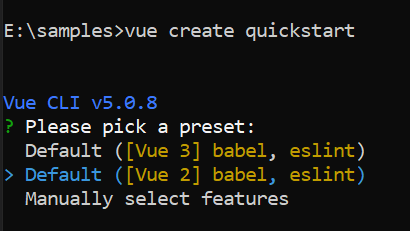Getting Started with the Vue Button group Component in Vue 2
25 Apr 20258 minutes to read
This article provides a step-by-step guide for setting up a Vue 2 project using Vue-CLI and integrating the Syncfusion® Vue Button group component using the Composition API / Options API.
Prerequisites
System requirements for Syncfusion® Vue UI components
Dependencies
The list of dependencies required to use the Button component in your application is given below:
|-- @syncfusion/ej2-vue-splitbuttons
|-- @syncfusion/ej2-base
|-- @syncfusion/ej2-buttons
|-- @syncfusion/ej2-vue-baseSetting up the Vue 2 project
To generate a Vue 2 project using Vue-CLI, use the vue create command. Follow these steps to install Vue CLI and create a new project:
npm install -g @vue/cli
vue create quickstart
cd quickstart
npm run serveor
yarn global add @vue/cli
vue create quickstart
cd quickstart
yarn run serveWhen creating a new project, choose the option Default ([Vue 2] babel, eslint) from the menu.

Once the quickstart project is set up with default settings, proceed to add Syncfusion® components to the project.
Add Syncfusion® Vue packages
Syncfusion® packages are available at npmjs.com. To use Vue components, install the required npm package.
This article uses the Vue Button group component as an example. Install the @syncfusion/ej2-splitbuttons package by running the following command:
npm install @syncfusion/ej2-vue-splitbuttons --saveor
yarn add @syncfusion/ej2-vue-splitbuttonsImport Syncfusion® CSS styles
You can import themes for the Syncfusion® Vue component in various ways, such as using CSS or SASS styles from npm packages, CDN, CRG and Theme Studio. Refer to themes topic to know more about built-in themes and different ways to refer to themes in a Vue project.
In this article, the Material theme is applied using CSS styles, which are available in installed packages. The necessary Material CSS styles for the Button group component and its dependents were imported into the <style> section of src/App.vue file.
<style>
@import "../node_modules/@syncfusion/ej2-base/styles/material.css";
@import "../node_modules/@syncfusion/ej2-buttons/styles/material.css";
@import "../node_modules/@syncfusion/ej2-popups/styles/material.css";
@import "../node_modules/@syncfusion/ej2-splitbuttons/styles/material.css";
</style>Add Syncfusion® Vue component
Follow the below steps to add the Vue Button group component using Composition API or Options API:
1. First, import and register the Button group component in the script section of the src/App.vue file. If you are using the Composition API, you should add the setup attribute to the script tag to indicate that Vue will be using the Composition API.
<script setup>
import { ButtonComponent as EjsButton } from '@syncfusion/ej2-vue-buttons';
</script><script>
import { ButtonComponent } from '@syncfusion/ej2-vue-buttons';
export default {
components: {
'ejs-button': ButtonComponent
}
}
</script>Creating Vue Sample
Add a div element with class name as e-btn-group and add the button elements that needs to be group inside the div element in App.vue file.
To render button elements as EJ2 Vue Button, then add Button dependencies in systemjs.config.js file. Then import ButtonPlugin from ej2-vue-buttons.
<template>
<div id='app'>
<div class="e-btn-group">
<ejs-button>HTML</ejs-button>
<ejs-button>CSS</ejs-button>
<ejs-button>Javascript</ejs-button>
</div>
</div>
</template>Here is the summarized code for the above steps in the src/App.vue file:
<template>
<div id='app'>
<div class="e-btn-group">
<ejs-button>HTML</ejs-button>
<ejs-button>CSS</ejs-button>
<ejs-button>Javascript</ejs-button>
</div>
</div>
</template>
<script setup>
import { ButtonComponent as EjsButton } from '@syncfusion/ej2-vue-buttons';
</script>
<style>
@import "../node_modules/@syncfusion/ej2-base/styles/material.css";
@import "../node_modules/@syncfusion/ej2-buttons/styles/material.css";
@import "../node_modules/@syncfusion/ej2-popups/styles/material.css";
@import "../node_modules/@syncfusion/ej2-splitbuttons/styles/material.css";
#app {
margin: 20px;
}
.e-btn-group {
margin: 25px 5px 20px 20px;
}
</style><template>
<div id='app'>
<div class="e-btn-group">
<ejs-button>HTML</ejs-button>
<ejs-button>CSS</ejs-button>
<ejs-button>Javascript</ejs-button>
</div>
</div>
</template>
<script>
import { ButtonComponent } from '@syncfusion/ej2-vue-buttons';
export default {
components: {
'ejs-button': ButtonComponent
},
name: 'app'
}
</script>
<style>
@import "../node_modules/@syncfusion/ej2-base/styles/material.css";
@import "../node_modules/@syncfusion/ej2-buttons/styles/material.css";
@import "../node_modules/@syncfusion/ej2-popups/styles/material.css";
@import "../node_modules/@syncfusion/ej2-splitbuttons/styles/material.css";
#app {
margin: 20px;
}
.e-btn-group {
margin: 25px 5px 20px 20px;
}
</style>Run the project
To run the project, use the following command:
npm run serveor
yarn run serveOrientation
ButtonGroup can be arranged in vertical and horizontal orientation. By default, it is horizontally aligned.
Vertical Orientation
ButtonGroup can be aligned vertically using the built-in CSS class e-vertical to the target element.
The following example illustrates how to achieve vertical orientation in ButtonGroup,
<template>
<div id='app'>
<div class="e-btn-group e-vertical">
<ejs-button >HTML</ejs-button>
<ejs-button >CSS</ejs-button>
<ejs-button >Javascript</ejs-button>
</div>
</div>
</template>
<script setup>
import { ButtonComponent as EjsButton } from '@syncfusion/ej2-vue-buttons';
</script>
<style>
@import "../node_modules/@syncfusion/ej2-base/styles/material.css";
@import "../node_modules/@syncfusion/ej2-buttons/styles/material.css";
@import "../node_modules/@syncfusion/ej2-popups/styles/material.css";
@import "../node_modules/@syncfusion/ej2-splitbuttons/styles/material.css";
#app {
margin: 20px;
}
.e-btn-group {
margin: 25px 5px 20px 20px;
}
</style><template>
<div id='app'>
<div class="e-btn-group e-vertical">
<ejs-button >HTML</ejs-button>
<ejs-button >CSS</ejs-button>
<ejs-button >Javascript</ejs-button>
</div>
</div>
</template>
<script>
import { ButtonComponent } from '@syncfusion/ej2-vue-buttons';
export default {
components: {
'ejs-button': ButtonComponent
},
name: 'app'
}
</script>
<style>
@import "../node_modules/@syncfusion/ej2-base/styles/material.css";
@import "../node_modules/@syncfusion/ej2-buttons/styles/material.css";
@import "../node_modules/@syncfusion/ej2-popups/styles/material.css";
@import "../node_modules/@syncfusion/ej2-splitbuttons/styles/material.css";
#app {
margin: 20px;
}
.e-btn-group {
margin: 25px 5px 20px 20px;
}
</style>ButtonGroup with SplitButton component nesting won’t works in vertical orientation.